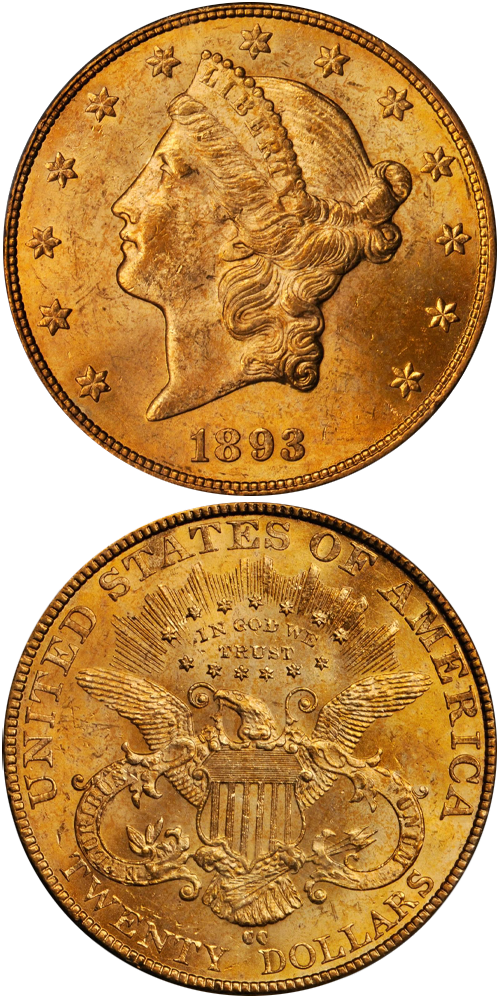1893-CC Liberty Head Double Eagle
Jeff Ambio: The two known die marriages of the 1893-CC double eagle are distinguished by looking at the obverse. On examples of Winter 2-A, the date logotype is set low in the field and is closer to the denticles than the base of Liberty's portrait. The left edge of the lower serif of the digit 1 is over the center of a denticle. Both varieties share the same reverse, identifiable by a medium size, closely spaced CC mintmark. The first C is right of center over the space between the words TWENTY and DOLLARS while the second C is over the left side of the upright of the letter D in DOLLARS.
Rusty Goe: The Philadelphia Mint had resumed its vigorous production of double eagles in 1893, at the same time it would take its quotas of half eagles and eagles to loftier levels. The San Francisco branch continued its role as the nation's largest supplier of $20 gold pieces, as it too increased its volumes of the two smaller denomination gold coins.
Cleveland's administration had enlisted the efforts of all of the working mints to produce as many gold coins as possible in 1893, except of course the one in Nevada (although the Carson branch did emit one last hurrah of a substantial quantity -- for it -- of half eagles that year).
Cleveland's Mint Director, Robert E. Preston, who had previously served as an acting director during the terms of Linderman, Burchard, and Kimball, wrote about the Carson Mint's production halt in his 1893 annual report. He said the days of accumulating "an amount of gold coin at a point where it is not required," at the Carson Mint had ended.
We don't know how many gold coins had accumulated in the Carson branch's vault by the time Mint Bureau inspectors came in June to tally the books. But we do know that Coiner Charles Colburn had delivered a little more than $800,000 in face value of them before the end came. Double eagles accounted for 46 percent of that total -- 18,402 pieces.
By the time Colburn had finished oiling the presses, tidying up his tools, and cleaning up his coining department, in June-July 1893, miners on the Comstock were closing down operations as well. The Lode had given up about all of the good pay-ore it had stored in its once-rich veins.
Q. David Bowers: In a study I did of double eagles a few years ago I estimated that about 500 to 800 exist all told from this last year of production, of which perhaps 175 to 250 are really Uncirculated. Most are MS-60 to MS-62, occasionally MS-63. As far back as 1982 David W. Akers stated that in Mint State the 1893-CC is the most populous of all Carson City twenties. Since that time the 1875-CC has bumped the 1893-CC from this position.
EF and AU coins abound from late 20th century imports. Collectors of the pre-1950 era had sparse pickings, with VF and EF being the order of the day.
At the end of double eagle coinage at the Carson City Mint in 1893, the total production at that facility of this denomination from 1870 onward totaled 864,128. In Philadelphia the figure was 5,435,670, and in San Francisco, near mining sources, the number was 23,880,400. At New Orleans this denomination was made only in 1879 and just to the extent of 2,325 pieces.
The example to the left was sold by Stack's Bowers Galleries in the June 2013 Baltimore Auction, where it realized $44,062.






